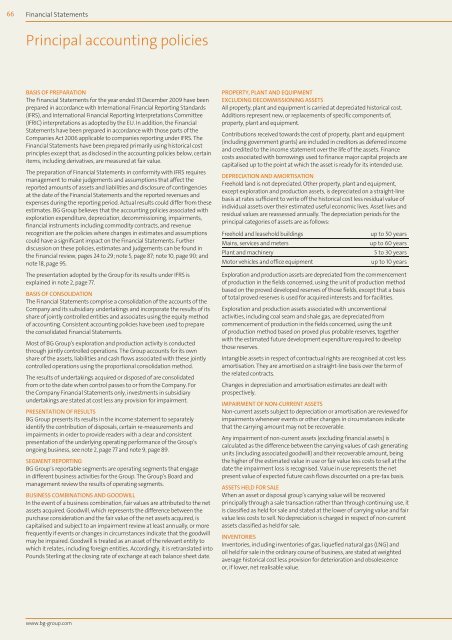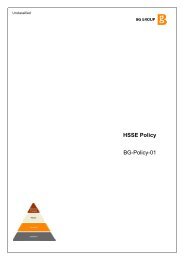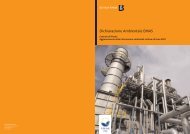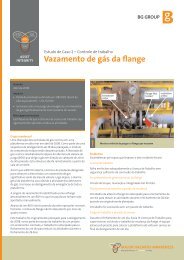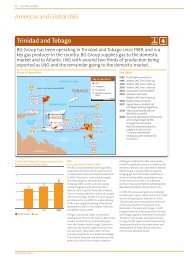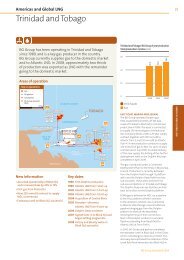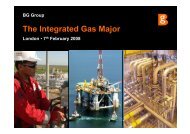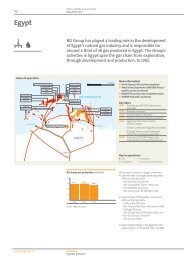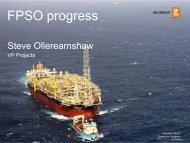Annual Report and Accounts 2009 - BG Group
Annual Report and Accounts 2009 - BG Group
Annual Report and Accounts 2009 - BG Group
You also want an ePaper? Increase the reach of your titles
YUMPU automatically turns print PDFs into web optimized ePapers that Google loves.
66<br />
Financial Statements<br />
Principal accounting policies<br />
BASIS OF PREPARATION<br />
The Financial Statements for the year ended 31 December <strong>2009</strong> have been<br />
prepared in accordance with International Financial <strong>Report</strong>ing St<strong>and</strong>ards<br />
(IFRS), <strong>and</strong> International Financial <strong>Report</strong>ing Interpretations Committee<br />
(IFRIC) interpretations as adopted by the EU. In addition, the Financial<br />
Statements have been prepared in accordance with those parts of the<br />
Companies Act 2006 applicable to companies reporting under IFRS. The<br />
Financial Statements have been prepared primarily using historical cost<br />
principles except that, as disclosed in the accounting policies below, certain<br />
items, including derivatives, are measured at fair value.<br />
The preparation of Financial Statements in conformity with IFRS requires<br />
management to make judgements <strong>and</strong> assumptions that affect the<br />
reported amounts of assets <strong>and</strong> liabilities <strong>and</strong> disclosure of contingencies<br />
at the date of the Financial Statements <strong>and</strong> the reported revenues <strong>and</strong><br />
expenses during the reporting period. Actual results could differ from these<br />
estimates. <strong>BG</strong> <strong>Group</strong> believes that the accounting policies associated with<br />
exploration expenditure, depreciation, decommissioning, impairments,<br />
financial instruments including commodity contracts, <strong>and</strong> revenue<br />
recognition are the policies where changes in estimates <strong>and</strong> assumptions<br />
could have a significant impact on the Financial Statements. Further<br />
discussion on these policies, estimates <strong>and</strong> judgements can be found in<br />
the Financial review, pages 24 to 29; note 5, page 87; note 10, page 90; <strong>and</strong><br />
note 18, page 95.<br />
The presentation adopted by the <strong>Group</strong> for its results under IFRS is<br />
explained in note 2, page 77.<br />
BASIS OF CONSOLIDATION<br />
The Financial Statements comprise a consolidation of the accounts of the<br />
Company <strong>and</strong> its subsidiary undertakings <strong>and</strong> incorporate the results of its<br />
share of jointly controlled entities <strong>and</strong> associates using the equity method<br />
of accounting. Consistent accounting policies have been used to prepare<br />
the consolidated Financial Statements.<br />
Most of <strong>BG</strong> <strong>Group</strong>’s exploration <strong>and</strong> production activity is conducted<br />
through jointly controlled operations. The <strong>Group</strong> accounts for its own<br />
share of the assets, liabilities <strong>and</strong> cash flows associated with these jointly<br />
controlled operations using the proportional consolidation method.<br />
The results of undertakings acquired or disposed of are consolidated<br />
from or to the date when control passes to or from the Company. For<br />
the Company Financial Statements only, investments in subsidiary<br />
undertakings are stated at cost less any provision for impairment.<br />
PRESENTATION OF RESULTS<br />
<strong>BG</strong> <strong>Group</strong> presents its results in the income statement to separately<br />
identify the contribution of disposals, certain re-measurements <strong>and</strong><br />
impairments in order to provide readers with a clear <strong>and</strong> consistent<br />
presentation of the underlying operating performance of the <strong>Group</strong>’s<br />
ongoing business, see note 2, page 77 <strong>and</strong> note 9, page 89.<br />
SEGMENT REPORTING<br />
<strong>BG</strong> <strong>Group</strong>’s reportable segments are operating segments that engage<br />
in different business activities for the <strong>Group</strong>. The <strong>Group</strong>’s Board <strong>and</strong><br />
management review the results of operating segments.<br />
BUSINESS COMBINATIONS AND GOODWILL<br />
In the event of a business combination, fair values are attributed to the net<br />
assets acquired. Goodwill, which represents the difference between the<br />
purchase consideration <strong>and</strong> the fair value of the net assets acquired, is<br />
capitalised <strong>and</strong> subject to an impairment review at least annually, or more<br />
frequently if events or changes in circumstances indicate that the goodwill<br />
may be impaired. Goodwill is treated as an asset of the relevant entity to<br />
which it relates, including foreign entities. Accordingly, it is retranslated into<br />
Pounds Sterling at the closing rate of exchange at each balance sheet date.<br />
www.bg-group.com<br />
PROPERTY, PLANT AND EQUIPMENT<br />
EXCLUDING DECOMMISSIONING ASSETS<br />
All property, plant <strong>and</strong> equipment is carried at depreciated historical cost.<br />
Additions represent new, or replacements of specific components of,<br />
property, plant <strong>and</strong> equipment.<br />
Contributions received towards the cost of property, plant <strong>and</strong> equipment<br />
(including government grants) are included in creditors as deferred income<br />
<strong>and</strong> credited to the income statement over the life of the assets. Finance<br />
costs associated with borrowings used to finance major capital projects are<br />
capitalised up to the point at which the asset is ready for its intended use.<br />
DEPRECIATION AND AMORTISATION<br />
Freehold l<strong>and</strong> is not depreciated. Other property, plant <strong>and</strong> equipment,<br />
except exploration <strong>and</strong> production assets, is depreciated on a straight-line<br />
basis at rates sufficient to write off the historical cost less residual value of<br />
individual assets over their estimated useful economic lives. Asset lives <strong>and</strong><br />
residual values are reassessed annually. The depreciation periods for the<br />
principal categories of assets are as follows:<br />
Freehold <strong>and</strong> leasehold buildings up to 50 years<br />
Mains, services <strong>and</strong> meters up to 60 years<br />
Plant <strong>and</strong> machinery 5 to 30 years<br />
Motor vehicles <strong>and</strong> office equipment up to 10 years<br />
Exploration <strong>and</strong> production assets are depreciated from the commencement<br />
of production in the fields concerned, using the unit of production method<br />
based on the proved developed reserves of those fields, except that a basis<br />
of total proved reserves is used for acquired interests <strong>and</strong> for facilities.<br />
Exploration <strong>and</strong> production assets associated with unconventional<br />
activities, including coal seam <strong>and</strong> shale gas, are depreciated from<br />
commencement of production in the fields concerned, using the unit<br />
of production method based on proved plus probable reserves, together<br />
with the estimated future development expenditure required to develop<br />
those reserves.<br />
Intangible assets in respect of contractual rights are recognised at cost less<br />
amortisation. They are amortised on a straight-line basis over the term of<br />
the related contracts.<br />
Changes in depreciation <strong>and</strong> amortisation estimates are dealt with<br />
prospectively.<br />
IMPAIRMENT OF NON-CURRENT ASSETS<br />
Non-current assets subject to depreciation or amortisation are reviewed for<br />
impairments whenever events or other changes in circumstances indicate<br />
that the carrying amount may not be recoverable.<br />
Any impairment of non-current assets (excluding financial assets) is<br />
calculated as the difference between the carrying values of cash generating<br />
units (including associated goodwill) <strong>and</strong> their recoverable amount, being<br />
the higher of the estimated value in use or fair value less costs to sell at the<br />
date the impairment loss is recognised. Value in use represents the net<br />
present value of expected future cash flows discounted on a pre-tax basis.<br />
ASSETS HELD FOR SALE<br />
When an asset or disposal group’s carrying value will be recovered<br />
principally through a sale transaction rather than through continuing use, it<br />
is classified as held for sale <strong>and</strong> stated at the lower of carrying value <strong>and</strong> fair<br />
value less costs to sell. No depreciation is charged in respect of non-current<br />
assets classified as held for sale.<br />
INVENTORIES<br />
Inventories, including inventories of gas, liquefied natural gas (LNG) <strong>and</strong><br />
oil held for sale in the ordinary course of business, are stated at weighted<br />
average historical cost less provision for deterioration <strong>and</strong> obsolescence<br />
or, if lower, net realisable value.


